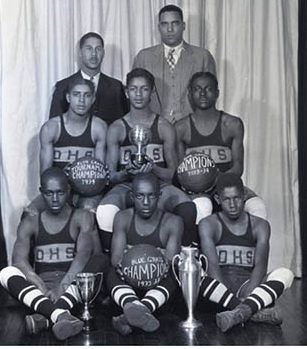Enoch: Oliver High School athletics
Published 8:00 am Saturday, February 18, 2023

- Coach Hubert Page’s team with trophies and basketballs labeled Bluegrass Champions 1932-33 and 1933-34 and Bluegrass Tournament Champions 1934. (Bluegrass Heritage Museum)
|
Getting your Trinity Audio player ready...
|
By Harry Enoch
Guest Columnist
Oliver High was one of only eight African-American high schools in Kentucky in the 1890s. Oliver’s storied athletic teams began early in the 20th century. Newspapers did not cover sports regularly in those days, so we have to rely on other sources. Two of importance are the late Louis Stout’s “Shadows of the Past” and Jeff Bridgeman’s “Kentucky High School Basketball Encyclopedia”.
The first known Oliver coach was William Taylor, who headed the girls’ basketball team. The 1921-22 girls’ squad, coached by Ernest Jackson “E. J.” Hooper, captured the Bluegrass League title with star players Rebecca Goodman, Lula Moore, Lena Bell, Mary K. Boone and Zelene Blythe. Oliver girls brought home another Bluegrass title in 1929.
E. J. Hooper also coached boys’ basketball and football. Hooper’s 1922-23 basketball team won the Bluegrass League championship with a 12-4 record. His 1923 football team played powerful Lexington Dunbar to a scoreless tie and brought home yet another league championship.
Louis Stout provided names of the 1923 football standouts: Brent Pendleton, William Bean, John Mark Givens, Sidney Green, Arthur Mance, Brutus Denny, Barry Moore, Phillip Ecton, James Drummon, Robert Taylor, Carl Williams, Arlington Williams, William Didlick and Allen Burnam. Leading players on the basketball team that year included Pendleton, Bean, Green, Mance, Denny, Moore and Carl Williams. Coach Hooper was a respected educator who left Oliver for a teaching position at Louisville and then Indianapolis.Over the coming decades, Oliver excelled in basketball. Coach James Nance took over in 1923, and his first two teams went 14-2 and 14-3. They were the Bluegrass League champs in 1925. Nance stayed six years and led the team to four winning seasons.
Winchester newspapers did not report the scores of Oliver High games. The African-American community had a regular column, called “Colored News,” written by a local minister and mostly covered church-related events. An exception was the January 29, 1926 issue of the Sun that featured “Oliver Hi Notes.”
“The fans of Winchester will miss the fastest and most thrilling game of the season if they do not see the Fighting Sheiks in action against the highly touted boys from Louisville. It will be remembered that it was the Louisville ‘Y’ that beat the Sheiks in ’23. Can they do it in ’26?”
There were some familiar names among the Oliver players going against Louisville: Bean, Williams, Patton, Green, Didlick and Burnam. Sadly, later issues of the Sun failed to report the outcome of the game. The school got a new gym in 1928. I have been unable to find when the “Fighting Sheiks” changed their name to the “Bobcats.”
Oliver High began a true basketball dynasty with the arrival of Coach Hubert Page in 1929. In Page’s first five seasons he racked up 104 wins against only 19 losses. He won the Bluegrass championship three years in a row—1932, 1933, 1934—with teams that went 21-5, 26-2, 25-3. The 1932 team finished third in the state tournament, and the 1934 team won it, beating Frankfort Mayo Underwood in the title game.
Page went on to coach 23 seasons at Oliver. During that time he won an incredible 71 percent of his games, compiling a 470-196 record. Remarkably, Page’s teams suffered only one losing season, going 10-12 in 1938-39. Little information could be gathered about the teams in those years. Scores of games occasionally appeared in the Sun’s“Colored Notes.”
I have been unable to learn more about Coach Page during or after his time at Oliver. Personal information in his 1969 obituary was disappointingly brief: “Hubert H. Page, Louisville, former coach at Oliver School, died early Friday morning at a Louisville Hospital after a short illness.”
Oliver’s legendary Joe Gilliam coached football for only three seasons He won the state championship in 1954 with an 8-1 record, losing only to perennial power Lexington Dunbar, 7-6. Gilliam went on to a successful career at Tennessee State University and earned a place in the Tennessee Sports Hall of Fame. And his son, Joe Jr., played quarterback for the Pittsburgh Steelers.
Joe Gilliam followed Page at Oliver, and the noted football coach proved almost as good at basketball. His three teams—1952-1955—finished with records of 17-8, 21-6, 20-8.
The Bluegrass Heritage Museum has a copy of Louis Stout’s hard-to-find “Shadow’s of the Past”, which details the history of teams in the Bluegrass League. (The museum also has two Oliver trophies, one for football and one for basketball.) Bridgeman’s “Kentucky High School Basketball Encyclopedia” can checked out at the Clark County Public Library. These are the only two works I have found that compiled records of athletic teams at black schools.
Harry Enoch is a native of Mt. Sterling and now resides in Winchester. He trained as a research biochemist and since retiring has focused on historic preservation, local history research and writing. He is the author of several books on Clark County history.





